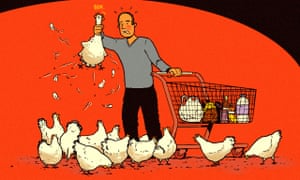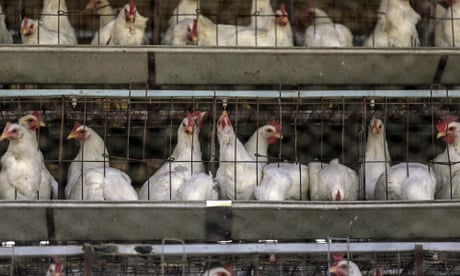
When he was a schoolboy, the great polymath Jonathan Miller won a reputation as the finest chicken impersonator in north London.
The pleasure his friends and family took in his performance had encouraged him to get the linguistics absolutely right. Rival impersonators at his school were happy to make do with “buk, buk, buk, buk … bacagh” but the future satirist, actor, opera director and neuropsychologist noticed that the noise chickens made wasn’t so regular, that “chickens liked to lead you up the garden path”, as he wrote in Granta magazine in 1988.
“They would lead you to expect that for every four or five ‘buks’ there would be a ‘bacagh’ … What I noticed, after prolonged examination, was an entirely different pattern of chicken speech behaviour. Thus: Buk, buk, buk, buk, buk, buk, bacagh, buk, buk, bacagh, buk, buk, buk, buk, buk, buk, buk, buk, buk … BACAGH, buk, buk …”
There was a war on – rationing, a shortage of eggs. Miller knew chickens intimately because his father, a military psychiatrist, kept them, and towed them in a trailer behind the car as the family moved from one hospital posting to the next.
My own family’s chickens, perhaps kept a little later than Miller’s but for similar reasons, weren’t so well travelled. They merely moved out of their shed in the daytime and back again at night, through a little door that could be lowered and raised like a shutter in an old-fashioned railway booking office.
The industrialisation of the meat supply, which began in the 19th century, worked both for and against compassion
When we got rid of the chickens this sliding door was nailed shut, to survive until the shed’s demolition 50 years later as a mysterious architectural feature that made sense only to those of us who’d seen the creatures stalking cautiously through it – “buk, buk, buk” – in those faraway days of cod liver oil and powdered egg.
What happened to the inmates? My memory is inexact, but I remember a scene in the kitchen: a hen fluttering and squawking (“BACAGH”), my father laughing and half-crying at the same time. “I cannie do it, I just cannie do it.” The hen was a favourite of his called Betty, and what he couldn’t bring himself to do was wring her neck. I don’t know what happened next, or what became of Betty’s four or five companions – perhaps they were sold or given away, or had their necks successfully wrung.
I also don’t recall eating any chicken, and chicken on the menu would have been rare enough to be memorable then, and in our house and many other houses would remain so into the 1960s. All that remains is an image: a frightened hen and its frustrated would-be killer.
Two weeks ago, when the Guardian and ITV published their undercover investigation into dubious work practices at a West Midlands chicken factory, that memory prompted a fantastical calculation. The plant’s owner, the 2 Sisters Food Group, kills and processes 6 million chickens every week. Other firms in the UK kill another 11 million chickens, which means the country contributes about 875 million chickens every year to the global total of more than 50 billion that are reared and killed annually for food.
If only a tiny proportion of these birds were looked on affectionately by the people who killed them, the distress added to humankind would still be considerable: my fantastical calculation imagined that kitchen scene of 60-odd years ago multiplied many million times, like frames in a very long film, each flickering with remorse.
Of course, the ever-moving production lines of the industrial food system spare workers no time to reflect. And they’ve come after all – from 36 different countries, in the case of 2 Sisters – to make money rather than campaign for animal rights.
And of course, the point of the Guardian-ITV story was to raise concerns on the consumer’s behalf rather than the animals’, with footage showing chicken pieces being retrieved from the factory floor and thrown straight back on to the production line, and evidence that packets contained chicken older than the sellby dates suggested.
But while these malpractices may threaten human health, they carry much less emotional weight than the sight of the slaughtering and cutting process itself, no matter how hygienic or well run. They seem like small breaches of discipline in the corner of a gory battlefield that we usually take care to avoid any sight of.
The industrialisation of the meat supply, which began in the 19th century, worked both for and against compassion. On the one hand, it broke the relationship between the animal and his human keeper by taking slaughter out of the farm and the butcher’s shop and confining it to the municipal abattoir, where beasts were literally poleaxed by slaughtermen whose only business was killing. On the other hand, it made a later generation uneasy about the invisible cruelty in their midst. In an increasingly urban and technological society, where animals were sentimentally attractive, the notion of “preventable suffering” grew.
Under the banner of its irreconcilable title, the Humane Slaughter Association campaigned for the humane mechanical killer – the stun gun – that was already used in parts of continental Europe when the association was founded in London in 1911.
By 1913 a Birmingham company, Accles & Shelvoke, had come up with something rather better – the captive-bolt Cash pistol, named after the animal welfarist Christopher Cash, who first had the idea. Since the Slaughter of Animals Act in 1933, Cash pistols have stunned most of Britain’s cattle, calves and sheep and made the fortune of Accles & Shelvoke, which surprisingly still exists to make them.
Poultry are not prepared for death that way. The big processing plants have two methods. In the older, the birds are hung by their legs from a moving line that swings them head-first into a bath of electrified water, which according to the strength and frequency of the current can either just stun the birds (if religious tradition insists they be kept alive for bleeding), or kill as well as stun them. In the newer method, using gas, the birds pass through a machine with a controlled atmosphere that makes them first unconscious and then dead.

If consumers knew how farmed chickens were raised, they might never eat their meat again
These aren’t pleasant facts, and yet in most cases they represent a kindness – a quick and sure death – that has been absent in a typical chicken’s life until that point.
Felicity Lawrence, the Guardian’s writer on the food industry, has vividly described the effects of the genetic research that has gone into finding the most economically efficient bird. Fleshy breasts are particularly important in the broiler chicken. “By day nine, the broiler’s legs can barely keep its oversized breast off the ground. By day 11, it is puffed up to double the size of its [egg-laying] cousin … By day 35, it looks more like a weightlifter on steroids … bones, hearts and lungs cannot keep up. A large proportion of broilers suffer from leg problems … Birds that sit in foul litter suffer more skin disease. Deaths from heart attacks or swollen hearts that cannot supply enough oxygen to their oversized breast muscles are also common.”
Poultry now accounts for about a half of all meat eaten in Britain. It’s cheap. The cruelty that goes into the making of it is unconscionable.